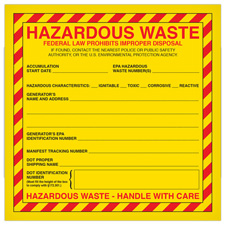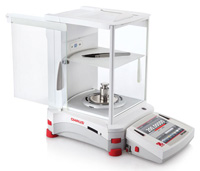



Find all of your laboratory and workplace safety supplies at Safety Emporium!
 Mixture |
 Glossary Index |
 Mouse |
| MSDS Topics |
Free Sites | FAQ's | Regulations | Glossary | Software | Suppliers |
| Books | Forum | Poll | Fun stuff | Quiz | Store | |
| Understand your MSDS with the MS-Demystifier | Search ALL our MSDS info | |||||
A mole (abbreviation: mol) is an amount of substance that contains as many objects (molecules, particles, ions, cells etc.) as the number of atoms in exactly 12 grams of 12C (carbon).
This number can be determined experimentally to be 6.022 x 1023 (602,200,000,000,000,000,000,000), a number which is called Avogadro's number. The mole is simply a convenient unit for dealing with large numbers just like it is easier to talk about the weight of a ship in tons rather than ounces.
"Mole" has several other possible meanings, of course, but none of these generally applies to Safety Data Sheets.

Get your hazardous waste labels from Safety Emporium.
A mole of anything has Avogadro's number of objects in it. So a mole of water (H2O) has 6.022 x 1023 water molecules, a mole of carbon atoms has 6.022 x 1023 carbon atoms and a mole of automobiles (rather unlikely) would have 6.022 x 1023 automobiles.
Clearly, if the objects we are talking about have different masses (weight), then a mole of one substance will also have a different mass than the other. So while a mole of 12C (carbon) atoms will weigh 12 grams, a mole of 197Au (gold) atoms will weigh 197 grams and a mole of sodium chloride (NaCl, table salt) will weigh 58.45 grams.
How were we able to tell you that? Using these terms and definitions:
Therefore, the atomic weight of a 12C atom is 12 amu. 14N atom has an atomic weight of 14 amu. You can look these values up in any chemistry textbook or on the web at WebElements.
Moles are used to calculate molarity, a unit of concentration most often used for liquid solutions. The formula and molecular weights are also included on Safety Data Sheets in case one needs to calculate a molarity, for example.
Physical property information such as molecular and formula weights is not required on Safety Data Sheets (and is not always applicable), but if this information is on there it will be found in Section 9 (physical and chemical properties) of the SDS.

Laboratory operations are a breeze with Ohaus analytical balances from Safety Emporium.
See also: Chemical formula, IUPAC, mass units, molarity.
Additional definitions from Google and OneLook.
Entry last updated: Tuesday, January 3, 2023. This page is copyright 2000-2025 by ILPI. Unauthorized duplication or posting on other web sites is expressly prohibited. Send suggestions, comments, and new entry desires (include the URL if applicable) to us by email.
Disclaimer: The information contained herein is believed to be true and accurate, however ILPI makes no guarantees concerning the veracity of any statement. Use of any information on this page is at the reader's own risk. ILPI strongly encourages the reader to consult the appropriate local, state and federal agencies concerning the matters discussed herein.